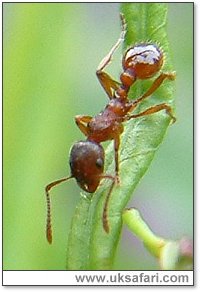
|

|
|
 Sent
to you Sent
to you
by e-mail
|
|
Simply
enter your details and hit the send button
more
info |
|


Click Here

Links
Advertise
Terms of Use
Contributors
About Us
Contact Us
|
 |
Go back
 | Bookmark
| Bookmark
 | Print Page
| Print Page  | E-Mail Us
| E-Mail Us 
 

Photo: G. Bradley |
|
UK Safari Tip:
To get a good look at ants you need to pick them up. The best way to do this
without harming them is with a gadget called a pooter - click
here
|
|
Latin name: Myrmica rubra
Size: Approximately 6mms long.
Distribution: Found throughout the U.K.
Months seen: All year.
Habitat: Nests under walls and old tree stumps. Commonly found in gardens
Food:
Some species are carnivorous, others are vegetarians. Myrmica rubra (right) is an omnivore.
Special features:
Most of us are familiar with the red and black garden ants, but
there are around 50 different species of ant in Britain. Many of them have
strong jaws and are capable of stinging.
Unlike most other insects, ants have extra body segments between the abdomen and
thorax. This 'waist' section is called the 'petiole'.
All ant species drink the
'honeydew' secretions from aphids.
 Ants act like farmers to the aphids. They protect the aphids from predators, like
ladybirds, and in exchange the aphids provide the ants with their sweet sugary
droppings. Some ant species even keep aphids in their underground nests for the same
purpose.
Ants act like farmers to the aphids. They protect the aphids from predators, like
ladybirds, and in exchange the aphids provide the ants with their sweet sugary
droppings. Some ant species even keep aphids in their underground nests for the same
purpose.
 In late summer and early autumn, particularly
in hot, stormy weather, swarms of
flying ants can be seen. In late summer and early autumn, particularly
in hot, stormy weather, swarms of
flying ants can be seen.
|
These swarms, sometimes called
'Ant weddings', are made up of male and queen ants, and
they take to the air in order to mate. After mating the males die. The
queens shed their wings and go off to set up new colonies.
Because ant weddings often happen just before a storm, when the air is very
still, it gave rise to the folklore that ants could foretell the coming of
thunderstorms.

UK Safari
Creepy-Crawlies Section
|
 |

|